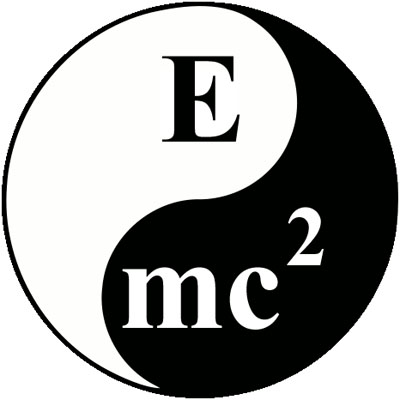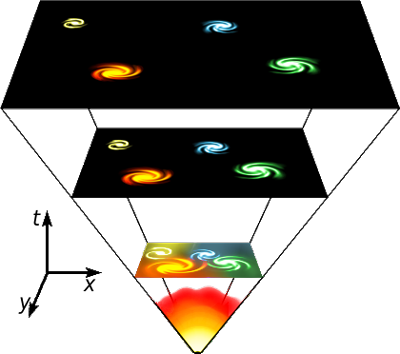 The Yin and Yang of Energy and Matter Credit: Ryan Somma |
Energy equals mass times the speed of light squared, E=mc2. When people think about this most popular of physics equations, they usually think of the awesome release of energy so starkly demonstrated in the mushroom cloud of an atomic blast, which is matter converting to energy when a uranium-235 nucleus breaks apart. 2.2 pounds of uranium yields 18.7 million kilowatt-hours of energy in a fission reaction, enough energy to power 2,100 100-watt light bulbs for ten years or one light bulb 21,000 years.
Perhaps the spectacular nature of this reaction is why so few people realize that the transformation flows both ways through the equal sign of Einstein’s equation. In fact, for much of the Universe’s history the conversion has gone the other way, energy becoming matter. E=mc2, but just as often m=E/c2. Mass equals Energy divided by the speed of light squared.
Let’s go back to the beginning of all existence. Pop. A single point explodes into what we call the Big Bang. At 10-43 of a second the universe had diffused enough energy for the force of gravity to emerge (10-43 of a second is 0.[insert 43 zeros here]1 or 1/1[insert 43 zeros here] of a second). From 10-33 of a second to 10-5 of a second quarks and anti-quarks, the sub-atomic particles that make up atomic particles, condensed out of the energy soup.
These quarks and anti-quarks condensed into protons and neutrons at 10-5 of a second. Three minutes later, these condensed into 75% hydrogen and 25% helium nuclei, the centers of atoms. 300,000 years later, the universe has cooled enough for hydrogen nuclei to begin capturing electrons into their atomic orbits, forming the first atoms.
600 million years after time started from zero, hydrogen clouds condensed into masses so great that they build enough pressure for gravity to fuse hydrogen nuclei together into helium atoms. The four hydrogen atoms have a combined mass of 4.0312 amu (Atomic Mass Units or 1.67377 x 10-24 of a gram), which become a single helium atom with a mass of 4.0026 amu and two positrons of 0.00055 amu each. The 0.0275 amu or 0.007 percent difference in masses is converted to energy according to E=mc2 and stars begin to ignite in fusion reactions, hatching from the hydrogen clouds, and the first galaxies condensed into being.
 Big Bang Theory of the Universe Credit: Gnixon and Fredrik |
Within the awesome pressure of stars, hydrogen atoms fuse into helium, helium fuse into carbon, carbon into neon, into oxygen, and then silicon, each fusion reaction marching up the periodic table all the way to iron. Starting from hydrogen’s atomic mass of 1.00794 amu, stars force matter together into iron’s atomic mass of 55.845 amu.
H > He > C > Ne > O > Si > Fe
Because the fusion reaction that generates iron produces no excess energy, and in fact absorbs energy, iron is the last element that can be formed inside a star’s core. Stars sufficiently saturated with iron collapse in on themselves, and then, like a hammer striking a rubber ball, rebound suddenly and violently in a explosion known as a supernova. This dramatic celestial phenomenon produces all the heavier elements that exist in the Universe today.
Occasionally, a star is too massive and its collapse too strong for it to rebound, and it continues to collapse into a point of infinite density and zero volume known as a black hole, a point so gravitationally dense that light cannot escape it and time practically comes to a stop in its vicinity. As the matter in our Universe grows denser, black holes will become more prevalent and stars will wink out of existence as all energy either freezes into matter or diffuses into a state of uniformity, but that’s still a trillion years in the future.
The more mass, the more potential energy. There is 300,000 kilometers per second multiplied by 300,000 kilometers per second multiplied by our individual mass of that capital letter “E” concentrated in all matter. We and everything around us is the lower-case “m,” and we are equal to E/c2.
So the classic Joni Mitchel lyric is also a scientific fact, “We are stardust, we are golden, We are billion year old carbon.”
Further Reading:
Note: In the interest of keeping this post pretty, I’ve used <sup> html tags to raise the number 2, in absence of these tags, the equation should read:
m = E/c^2
Sorry for any confusion.
Comments
7 responses to “m = E/c2 (m=E/c^2)”